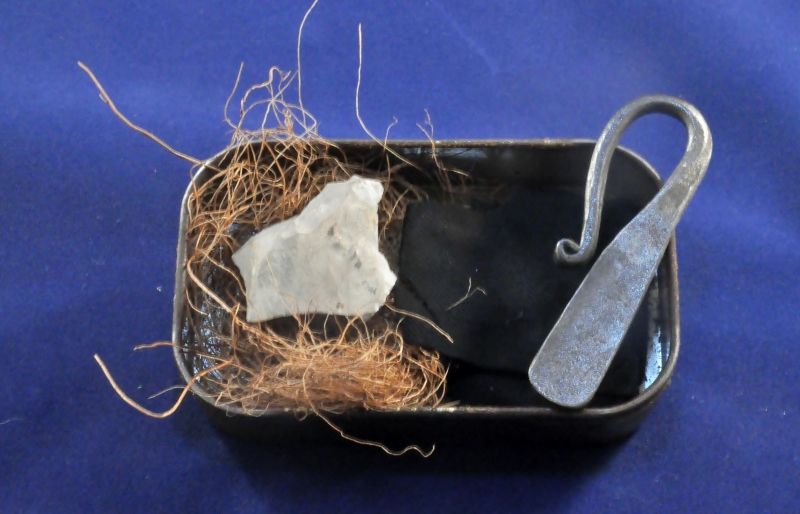
FireStriker Kit Instructions

FireStriker Kit Instructions
In The Tin, Firesteel, Flint, Charcloth, Natural Tinder
Please note that I test every Firesteel and Flint to ensure a strong spark. As with most skills starting a fire with a steel and flint takes some practice but once mastered
is extremely gratifying.
The Flint
This should have very sharp edges or it wont shave off tiny bits of steel from the firestriker to make a spark. See elsewhere on the internet on “knapping flint”
to do this. NB do not use the firesteel to knapp the flint you may shatter the steel!
The Firesteel
This is made of high carbon steel and is heat treated in such a way that it is brittle (see the advice on the flint above). Most of mine are based on a traditional Viking design
as the one in the Yorvik Centre in York. Please be aware that this is untreated steel and may arrive/become slightly rusty if exposed to damp. The oil from your skin or a
little light oil will remove/prevent this. Try and keep the striking face clean of any form of coating, or it simply wont work!
The Char Cloth
You can make sparks all day without causing so much as a wisp of smoke if you are not giving your sparks a happy and fruitful ground upon which to light.
The best material for such fire-starting is char cloth, which is simply linen or cotton cloth that has been burned in a low-oxygen environment
(I use a travel sweet tin with a close fitting lid). A small hole poked in the top allows smoke and pressure to escape without the oxygen burning the cloth completely.
To make char cloth, pack a small airtight tin with linen or cotton patches about 2 inches square. Place the tin on some hot coals in a fireplace or campfire and let it
cook for at least 20 minutes, or until the smoke subsides from the hole you poked in the top. Let it cool completely, and don’t open it for several hours or even overnight
– the cloth will catch flame and burn to a cinder. NB DO NOT DO THIS ON THE KITCHEN STOVE!
Tinder
The tinder supplied in this kit is coir usually used for lining hanging baskets. Other traditional tinder is Silver Birch bark. Look for the very thin strips that are naturally shed
from the tree trunk, another harder to find and use is Amadou which is the dried spongy part of the Horse Hoof Fungus found mainly in damp conditions on Birch trees.
You can resort to torn up paper towels or loo roll or the old SAS trick of cotton wool from a tampon! Whatever you use it Must Be Dry!
Technique
It’s pretty simple, actually. First, make sure your tinder is prepared and ready to accept your char cloth. Make a "nest" of the tinder, and put it where you can reach it easily.
Your fire bed should be already prepared with kindling and fuel and ready to accept your burning tinder. Holding the firesteel in your preferred hand and the flint in the
other ,place a small piece of char cloth on the top of the flint . The goal is to shave off a very small strip of metal that will burn and land on the char cloth. Striking down
at about a 30-degree angle with the steel onto the a sharp edge of the flint should create a spark or two, which will cause the cloth to glow red where they land.
This often happens on the edge of the cloth and may be hard to see in bright sunlight. If a spark lands on the char cloth, wait and blow gently on it until you see either
a glowing crescent or nothing. If nothing, go back to striking. You want to strike the flint with a fast glancing blow rather than a heavy one.
If you do have a glowing piece of char cloth, great! Fold it onto itself and blow gently to encourage the spark to spread. Here’s the wonderful thing about starting a fire
this way – the best time to do it is in the wind, where matches are blown out quickly. In fact, the stronger the wind, the faster your char will be consumed.
Place the glowing char into the prepared tinder nest and carefully fold it in on itself. Remember, you still need oxygen in there.Blowing gently will cause you to see
wisps of smoke coming from the bundle. Perfect. Just keep blowing, and pretty soon – POOF! You’ll be ready to start a fire.
With practice, you will be able to start fires consistently and often faster than with conventional methods, especially in adverse conditions.
Enjoy.
Simon